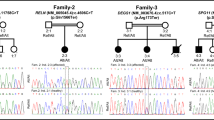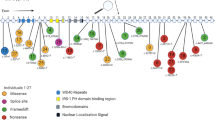Abstract
The genetics of migraine is a fascinating and rapidly moving research area. Familial hemiplegic migraine, a rare subtype of migraine with a Mendelian pattern of inheritance, is caused by mutations in the chromosome 19 CACNA1A gene or in the chromosome 1 ATP1A2 gene. Familial migraine variants are classified on the basis of clinical, descriptive criteria, but this is insufficient. In the future, a diagnostic classification based on mutationanalysis is needed.
Similar content being viewed by others
References and Recommended Reading
Whitty CW: Familial hemiplegic migraine. In Handbook of Clinical Neurology, vol 4. Edited by Rose FC. Amsterdam: Elsevier Science Publishers; 1986:141–153.
Russell MB: Genetic epidemiology of migraine and cluster headache. Cephalalgia 1997, 17:683–701.
Haan J, Terwindt G, Ophof R, et al.: Is familial hemiplegic migraine a hereditary form of basilar migraine? Cephalalgia 1995, 15:477–481.
Thomsen LL, Eriksen MK, Roemer SF, et al.: A populationbased study of familial hemiplegic migraine suggests revised diagnostic criteria. Brain 2002, 125:1379–1391. This epidemiological study provided clues for the revision of the criteria for FHM.
Thomsen LL, Olesen J, Russell MB: Increased risk of migraine with typical aura in probands with familial hemiplegic migraine and their relatives. Eur J Neurol 2003a, 10:421–427.
Thomsen LL, Ostergaard E, Olesen J, Russell MB: Evidence for a separate type of migraine with aura: sporadic hemiplegic migraine. Neurology 2003b, 60:595–601.
Joutel A, Bousser MG, Biousse V, et al.: A gene for familial hemiplegic migraine maps to chromosome 19. Nat Genet 1993, 5:40–45.
Joutel A, Ducros A, Vahedi K, et al.: Genetic heterogeneity of familial hemiplegic migraine. Am J Hum Genet 1994, 55:1166–1172.
Ophoff RA, Van Eijk R, Sandkuijl LA, et al.: Genetic heterogeneity of familial hemiplegic migraine. Genomics 1994, 22:21–26.
Terwindt GM, Ophoff RA, Haan J, et al.: Familial hemiplegic migraine: a clinical comparison of families linked and unlinked to chromosome 19. Cephalalgia 1996, 16:153–155.
Ducros A, Denier C, Joutel A, et al.: The clinical spectrum of familial hemiplegic migraine associated with mutations in a neuronal calcium channel. N Engl J Med 2001, 345:17–24.
Terwindt GM, Ophoff RA, Haan J, et al.: Variable clinical expression of mutations in the P/Q-type calcium channel gene in familial hemiplegic migraine: Dutch Migraine Genetics Research Group. Neurology 1998, 50:1105–1110.
Ophoff RA, Terwindt GM, Vergouwe MN, et al.: Familial hemiplegic migraine and episodic ataxia type-2 are caused by mutations in the Ca2+ channel gene CACNL1A4. Cell 1996, 87:543–552.
Ferrari MD, Haan J: The genetics of migraine: implications for treatment approaches. J Neural Transm 2002, 63(suppl):111–127. A recent review of the genetics of migraine.
Kors EE, Haan J, Giffin NJ, et al.: Expanding the phenotypic spectrum of the CACNA1A gene T666M mutation: a description of 5 families with familial hemiplegic migraine. Arch Neurol 2003, 60:684–688.
Fitzsimons RB, Wolfenden WH: Migraine coma. Brain 1985, 108:555–577.
Kors E, Terwindt GM, Vermeulen FL, et al.: Delayed cerebral edema and fatal coma after minor head trauma: role of the CACNA1A calcium channel subunit gene and relationship with familial hemiplegic migraine. Ann Neurol 2001, 49:753–760.
Ducros A, Joutel A, Vahedi K, et al.: Mapping of a second locus for familial hemiplegic migraine to 1q21–q23 and evidence of further heterogeneity. Ann Neurol 1997, 42:885–890.
Gardner K, Barmada MM, Ptacek LJ, Hoffman EP: A new locus for hemiplegic migraine maps to chromosome 1q31. Neurology 1997, 49:1231–1238.
Cevoli S, Pierangeli G, Monari L, et al.: Familial hemiplegic migraine: clinical features and probable linkage to chromosome 1 in an Italian family. Neurol Sci 2002, 23:7–10.
Marconi R, De Fusco M, Aridon P, et al.: Familial hemiplegic migraine type 2 is linked to 0.9Mb region on chromosome 1q23. Ann Neurol 2003, 53:376–381.
Lea RA, Sheperd AG, Curtain RP, et al.: A typical migraine susceptibility region localizes to chromosome 1q31. Neurogenetics 2002, 4:17–22.
Keryanov S, Gardner KL: Physical mapping and characterization of the human Na,K-ATPase isoform, ATP1A4. Gene 2002, 292:151–166.
De Fusco M, Marconi R, Silvestri L et al.: Haplo insuffiency of ATP1A2 encoding the Na/K pump a2 subunit associated with familial hemiplegic migraine type 2. Nat Genet 2003, 33:192–196. This article describes the finding of the FHM2 gene.
Vanmolkot KR, Kors EE, Hottenga JJ, et al.: Novel mutations in the Na+,K+-ATPase pump gene ATP1A2 associated with familial hemiplegic migraine and benign familial infantile convulsions. Ann Neurol 2003, 54:360–366.
Terwindt GM, Ophoff RA, Lindhout D, et al.: Partial cosegregation of hemiplegic migraine and benign infantile convulsions. Epilepsia 1997, 38:915–921.
Headache Classification Committee of the International Headache Society: Classification and diagnostic criteria for headache disorders, cranial neuralgias, and facial pain. Cephalalgia 1988, 8:1–96. The “old” migraine criteria.
Headache Classification Committee of the International Headache Society: The International Classification of Headache Disorders. Cephalalgia 2004, 24(suppl 1):1–160. The new migraine criteria.
Terwindt GM, Kors EE, Haan J, et al.: Mutation analysis of the CACNA1A calcium channel subunit gene in 27 patients with sporadic hemiplegic migraine. Arch Neurol 2002, 59:1016–1018.
Battistini S, Stenirri S, Piatti M, et al.: A new CACNA1A gene mutation in acetazolamide-responsive familial hemiplegic migraine and ataxia. Neurology 1999, 53:38–43.
Alonso I, Barros J, Tuna A, et al.: A novel R1347Q mutation in the predicted voltage sensor segment of the P/Q-type calcium-channel alpha-subunit in a family with progressive cerebellar ataxia and hemiplegic migraine. Clin Genet 2004, 65:70–72.
Alonso I, Barros J, Tuna A, et al.: Phenotypes of spinocerebellar ataxia type 6 and familial hemiplegic migraine caused by a unique CACNA1A missense mutation in patients from a large family. Arch Neurol 2003, 60:610–614.
Ducros A, Denier C, Joutel A, et al.: Recurrence of the T666M calcium channel CACNA1A gene mutation in familial hemiplegic migraine with progressive cerebellar ataxia. Am J Hum Genet 1999, 64:89–98.
Takahashi T, Igarashi S, Kimura T, et al.: Japanese cases of familial hemiplegic migraine with cerebellar ataxia carrying a T666M mutation in the CACNA1A gene. J Neurol Neurosurg Psychiatry 2002, 72:676–677.
Wada T, Kobayashi N, Takahashi Y, et al.: Wide clinical variability in a family with a CACNA1A T666m mutation: hemiplegic migraine, coma, and progressive ataxia. Pediatr Neurol 2002, 26:47–50.
Friend KL, Crimmins D, Phan TG, et al.: Detection of a novel missense mutation and second recurrent mutation in the CACNA1A gene in individuals with EA2 and FHM. Hum Genet 1999, 105:261–265.
Vahedi K, Denier C, Ducros A, et al.: CACNA1A gene de novo mutation causing hemiplegic migraine, coma, and cerebellar atrophy. Neurology 2000, 55:1040–1042.
Battistini S, Stenirri S, Piatti M, et al.: A new CACNA1A gene mutation in acetazolamide-responsive familial hemiplegic migraine and ataxia. Neurology 1999, 53:38–43.
Gardner K, Bernal O, Keegan M, et al.: A new mutation in the Chr 19p calcium channel gene CACNL1A4 causing hemiplegic migraine with ataxia. Neurology 1999, 52(suppl 20):A115-A116.
Author information
Authors and Affiliations
Rights and permissions
About this article
Cite this article
Haan, J., Kors, E.E., van den Maagdenberg, A.M.J.M. et al. Toward a molecular genetic classification of familial hemiplegic migraine. Current Science Inc 8, 238–243 (2004). https://doi.org/10.1007/s11916-004-0058-0
Issue Date:
DOI: https://doi.org/10.1007/s11916-004-0058-0




